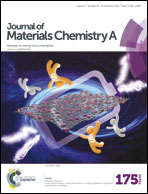Upcycling of nonporous coordination polymers: controllable-conversion toward porosity-tuned N-doped carbons and their electrocatalytic activity in seawater batteries†
Abstract
Herein, we report the preparation of highly porous N-doped carbons (PNCs) via thermolysis of nonporous Zn-based coordination polymers (CPs) constructed with nitrogen-containing ligands. So far, the thermal conversion of Zn-CPs, including metal–organic frameworks (MOFs), has mainly yielded microporous carbon materials, and to change the textural properties of end carbons, new CPs/MOFs with different properties were introduced. However, present studies show that just varying the conversion conditions of a parent CP results in porosity-tuned PNCs, in which especially mesoporosity is developed, and this is applicable for even nonporous CPs. This is conducted based on the understanding of conversion phenomena which is that during thermal conversion of Zn-based CPs, the in situ generated Zn metal species act as porogens and their agglomeration can be controlled by the reaction conditions. Different reaction temperatures, ramping rates and retention times allow control over the ratio of micro- to meso-pore volume, while a slower ramping rate and longer retention time at lower heating temperature induced the agglomeration of the porogens, yielding greater mesoporosity, and holding the Zn-CPs at high temperature for a short period afforded the micropore-dominant PNCs due to rapid porogen elimination. The superiority of the mesopore-developed PNCs as electrocatalysts, attributed to greater mass-transport-accessible surfaces, was examined for the electrodes in a rechargeable seawater battery system as an example of a practical application. Therefore, our synthetic approach provides a facile method for the preparation of PNCs with suitable hierarchical pore distributions for use as energy-related materials without exerting significant effort in the design of coordination compounds.


 Please wait while we load your content...
Please wait while we load your content...